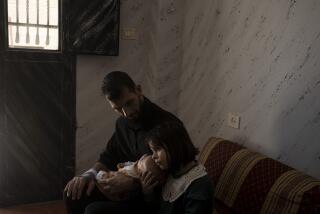Documents Reveal the Stories of Prisoners at Guantanamo Bay
WASHINGTON — Forced by a federal court to lift the cloak of secrecy that had long shrouded the U.S. prison at Guantanamo Bay, Cuba, the Pentagon released thousands of pages of documents Friday containing names and other details for hundreds of detainees scooped up after the Sept. 11 attacks.
The records provide the most comprehensive view to date of the Guantanamo prison population, as well as an exhaustive catalog of the U.S. government’s charges against detainees who -- in page after page of tribunal proceeding transcripts -- protest their treatment and proclaim their innocence.
The records render portraits of more than 300 current and former detainees. Some described themselves as farmers or low-level Taliban foot soldiers; some were accused by their U.S. captors of having attended Al Qaeda training camps and of being associates of senior terrorist operatives.
Several of those whose cases were detailed in the documents appeared to have close ties to senior Al Qaeda leaders, including alleged operations chief Abu Zubaydah, who is now in U.S. custody. Several of the detainees told Guantanamo military panels that Osama bin Laden’s followers were busy after Sept. 11 trying to provide cover for fleeing Al Qaeda trainees.
One prisoner identified only as Muhammed was described by the military as occasionally having been in charge of the notorious Khalden camp where thousands of Al Qaeda members trained. In one hearing, Muhammed was accused of conducting training in “mountain warfare” and in the use of machine guns, heavy weapons and rocket-propelled grenade launchers.
The detainee admitted to many of the charges but insisted he was not a member of Al Qaeda.
“I’d like to clear something up for you,” he said, according to the transcript. “I’m not the only trainer there; there were other trainers as well.”
Other captives appear to have been low-level fighters caught on the battlefield in Afghanistan. Qari Esmhatulla, an Afghan Pushtun, was captured during Operation Anaconda, the U.S. military offensive in the mountains of eastern Afghanistan in March 2002. He admitted he had carried a radio and hand grenades to Taliban fighters during the mountain battle.
The man said he helped the Taliban only because fellow villagers challenged him, asking why he was sitting at home while others fought the United States. According to the transcript, he said that in Pushtun culture, “it is a bad thing if you do not accept a challenge.”
Esmhatulla said he never intended to fight the U.S., only to “fight against Farsi-speaking people who have differences with the Pashtu-speaking people.”
The documents comprise more than 5,000 pages, transcripts of prisoners’ appearances before U.S. military tribunals to hear and, if desired, challenge the charges against them. Many detainees complained that the process -- facing a panel of U.S. military officers, with little or no ability to question witnesses or present evidence in their defense -- was inherently unfair.
One detainee opened his appearance before a tribunal by noting that the three panelists were members of the U.S. military.
“The U.S. military is my adversary,” the unidentified detainee complained, according to the transcript. “If the adversary is my judge ... I should not expect any justice.”
The head of the tribunal argued that “we are an impartial panel” and ultimately told the detainee: “This proceeding is going to go on with or without you. You are welcome to participate or not.”
Amid growing international criticism of the detentions, the Pentagon began holding annual hearings in late 2004 on whether prisoners ought to be released, be transferred to another country, or remain at Guantanamo Bay.
The review board judgments are based primarily on two criteria: whether the detainee continues to pose a threat to the United States and whether he may hold further intelligence that interrogators could use.
After 463 review boards were completed in December 2005, 329 prisoners were judged to require further detention; 120 were transferred to other countries and 14 were released.
The Pentagon released the documents late Friday to meet a deadline set last month by Judge Jed S. Rakoff of the U.S. District Court in New York. Rakoff rejected Bush administration arguments that releasing the detainees’ identities would violate their privacy and endanger them and their families.
The court order came as part of a lawsuit filed by the Associated Press, which sued the Pentagon under the Freedom of Information Act to release the names of detainees.
The Pentagon had previously released some of the documents with names and nationalities blacked out.
The avalanche of information is likely to intensify debate in the United States and abroad over whether the Guantanamo Bay detention facility is still holding prisoners who pose a serious threat or has outlived its usefulness in the war on terrorism.
Because they contain hundreds of names, the documents are also likely to be scrutinized by families in the Middle East and elsewhere seeking information on relatives in custody at Guantanamo. The Pentagon posted the documents at www.defenselink.mil/pubs/foi/detainees/csrt/index.html.
Most of the detainees apparently were captured during the 2001 U.S.-led attack that deposed the Taliban and forced Bin Laden and his followers into hiding along Afghanistan’s border with Pakistan. Many of the detainees are from Afghanistan, Pakistan, Egypt, Yemen and Algeria. Several said they were British citizens -- including Moazzam Begg and Feroz Ali Abbasi, who were released in Britain in 2005 -- and at least one identified himself as French.
The transcripts describe the circumstances of their capture, and offer a glimpse of the sort of evidence that U.S. military officials consider incriminating.
One detainee, for instance, was challenged to explain why he was found in possession of a certain model Casio wristwatch. That model watch “has been used in bombings that have been linked to Al Qaeda,” a tribunal official said.
“I didn’t know that watch was for the terrorists,” the detainee, a Yemeni, replied. “I saw a lot of American people wearing the same watch. Does that mean we’re all terrorists?”
Some prisoners apparently were in dire medical condition. One detainee caught fighting in Afghanistan tried to commit suicide by hanging himself in early 2003. The prisoner suffered “significant brain injury due to lack of oxygen,” according to the records, which noted that he was unlikely to recover his mental abilities but he might be able to follow “simple, concrete directions.”
Military officials determined that he remained a threat to the United States.
One detainee, Haji Ghalib, said he did not understand why he had been detained, because he had risked his life fighting against Al Qaeda and the Taliban and had captured many of them before he was captured himself.
He was accused in one proceeding of having been a Taliban commander in Shinwar, Afghanistan, and of having run a bomb-making facility. He described himself as a police chief and a staunch ally of the United States.
“For the last eight years I have fought the Taliban and Al Qaeda, and I also fought them at Tora Bora. It was a shock to me” to be accused of being an enemy of the United States, he said.
“I captured a lot of Al Qaeda and Arabs that were turned over to the Americans. I even went with U.S. forces to destroy the house of Osama bin Laden. All you have to do is check the record.”
The tribunal allowed a villager who had worked as a police officer for Ghalib to appear briefly as a witness for him at the proceeding. But the tribunal president said the Afghan government had not responded to Ghalib’s request that it provide two witnesses and documentary evidence that he said would exonerate him.
“We have allowed adequate time,” the unidentified tribunal official said.
In March 2003, the Daily Times of Pakistan reported on Ghalib’s arrest, saying authorities had received intelligence that he had “links” to Al Qaeda.
More to Read
Sign up for Essential California
The most important California stories and recommendations in your inbox every morning.
You may occasionally receive promotional content from the Los Angeles Times.










